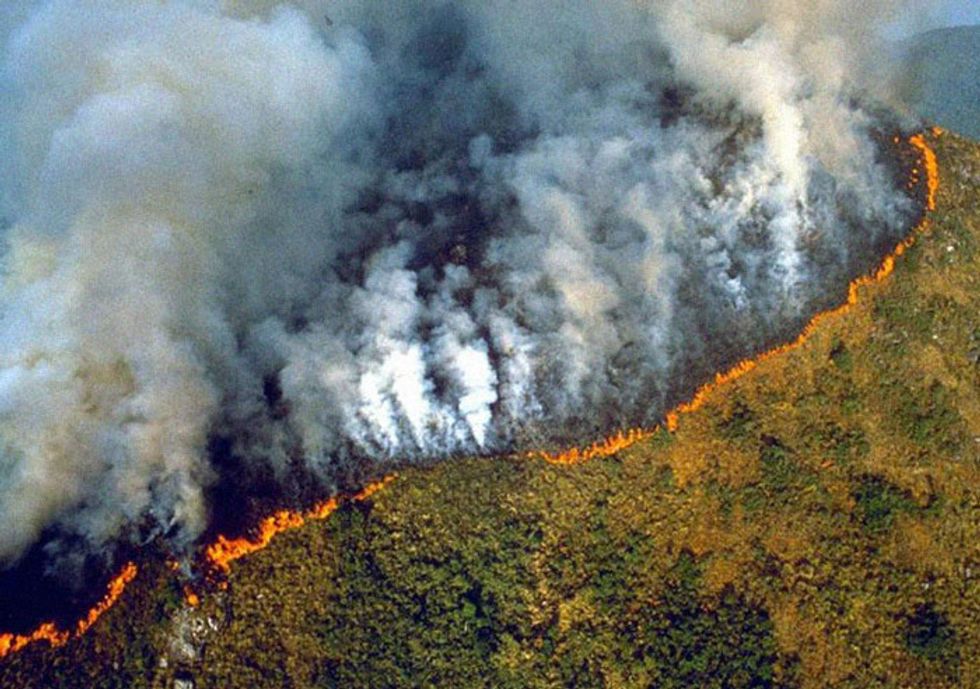Forty-eight hours...over one billion dollars raised all for a Gothic Cathedral. A building that many people have never seen in their lifetimes, and if they have it may not have been very often. This building provides nothing to the environment besides enjoyment and history. Compared to the estimate 55 billion-year-old Amazon Rainforest that encompasses more than 1.4 billion acres. That is almost the size of the 48 states at 1.9 billion acres. The ecosystem within the rainforest is detrimental to the earth as the Amazon Rainforest produces almost 20% of the world's oxygen while also taking in the high level of CO2.
The Amazon Rainforest is on fire and nobody is helping.
There are over 16,000 tree species, 40,000 plant species and estimated about 2.5 million species of insects. It is home to over 400 type of mammals,1,300 species of birds, 350 types of reptiles and more than 400 types of amphibians. There are species that are still being discovered in 2019. Over 30% of these species are on the endangered list including the tapir, giant otters, Uakari monkey, poison dart frog, orchid plants, Rafflesia and toucans.
Since the 1960's the size of the rainforest has dramatically dropped. Between the 1970s and 2005 over 686,978 squared kilometer were lost. As of 2014 that loss is about 760,551 squared kilometers. This deforestation is due to many reasons such as logging for paper uses as well as slash and burning for the expansion of agriculture and livestock ranches. Slash and burn is a method of farming that involves cutting down forestry and burning it to create a section of land called swidden. When the land becomes unfertile then move to another spot and repeat the cycle. A lot of this is because of the high demand of beef. Countries such as Russia which imports 321,058 tonnes of Brazilian beef annually.
This is getting out of hand as the Brazilian government, where over 60% of the rainforest exists, continues to turn a blind eye to the illegal activities that are occurring right under its nose including slash and burning. There has been an 84% increase of fires compared to this period last year according to the Brazil's National Institute of Space Research. The increase of fires and deforestation is occurring at a rapid alarming rate.
The damaged caused by deforestation is irreversible and will wreck havoc on local communities and potential the world and those that live here. It has also lead to indigenous both contacted and uncontacted to be completely wiped out as their homeland is being destroyed and many are coming in contact with diseases and bacteria that they have no immunity too and are having entire tribes being erased from existence. Animals are being pushed into extinction as their habitat and food sources are being destroyed and condensed together in smaller areas. As roads are being build, the species are more likely to come in contact with equipment that can injure or even kill them.
Soil erosion and disruption of the water cycle is another effect of the disforestation. Uplifting trees causes a disruption in the soil making it more loose because there are not root to hold the soil together. Without anything keeping the soil particles together, whenever it rains the layers of soil will wash away instead of taking in the water. This will lead to higher nutrients and chemicals entering water ways potential harming all forms of life. While an increase of nutrients may seem like a big deal but this increase can throw off the pH and balance in the waterways and lead horrible consequences.
So what can we do?
1. Start planting trees
Get a group of friends or hold a fundraiser and plant trees along rivers and creeks or locally within your community. For every tree, you uprooted, plant three new ones!
2. Stop printing and go paperless
While you do need to use papers for certain situations, almost every book can be found online and sometimes may even be cheaper!
3. Cut back on meat intake
As someone who loves a good ol' steak and chicken, this can be very difficult however, if you do not cut back, try buying from local farms and butchershops. More often than not these animals are typically treated in better condition than if they were owned by large multinational corporations. Buying organic can be expensive but if you shop locally, it usually isn't that much more in price.
4. Recycle paper and cardboard
If one ton of paper is recycled it saves 17 trees from being cut. If just 10 percent of all the paper used by the average American in one year were recycled, 25 million trees would be saved. Use cardboard boxes instead of plastic totes.
There are many more things that you can do as an individual. Take the time to do the research and find out what works for you. The earth will thank you.
- 'Slash-And-Burn Agriculture' Is Exactly As Bad As It Sounds ›
- The Amazon Rainforest Is In Serious Danger ›











